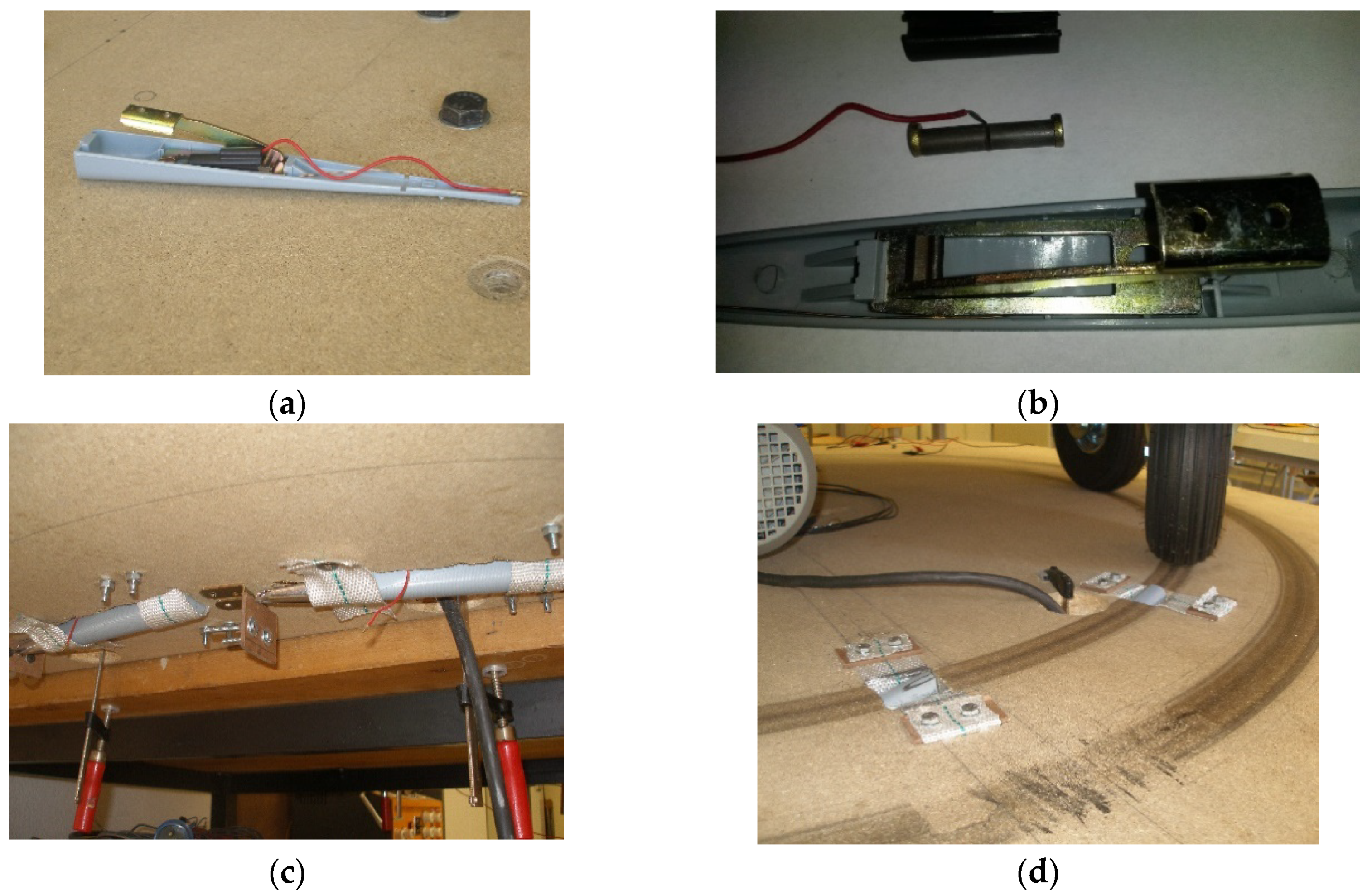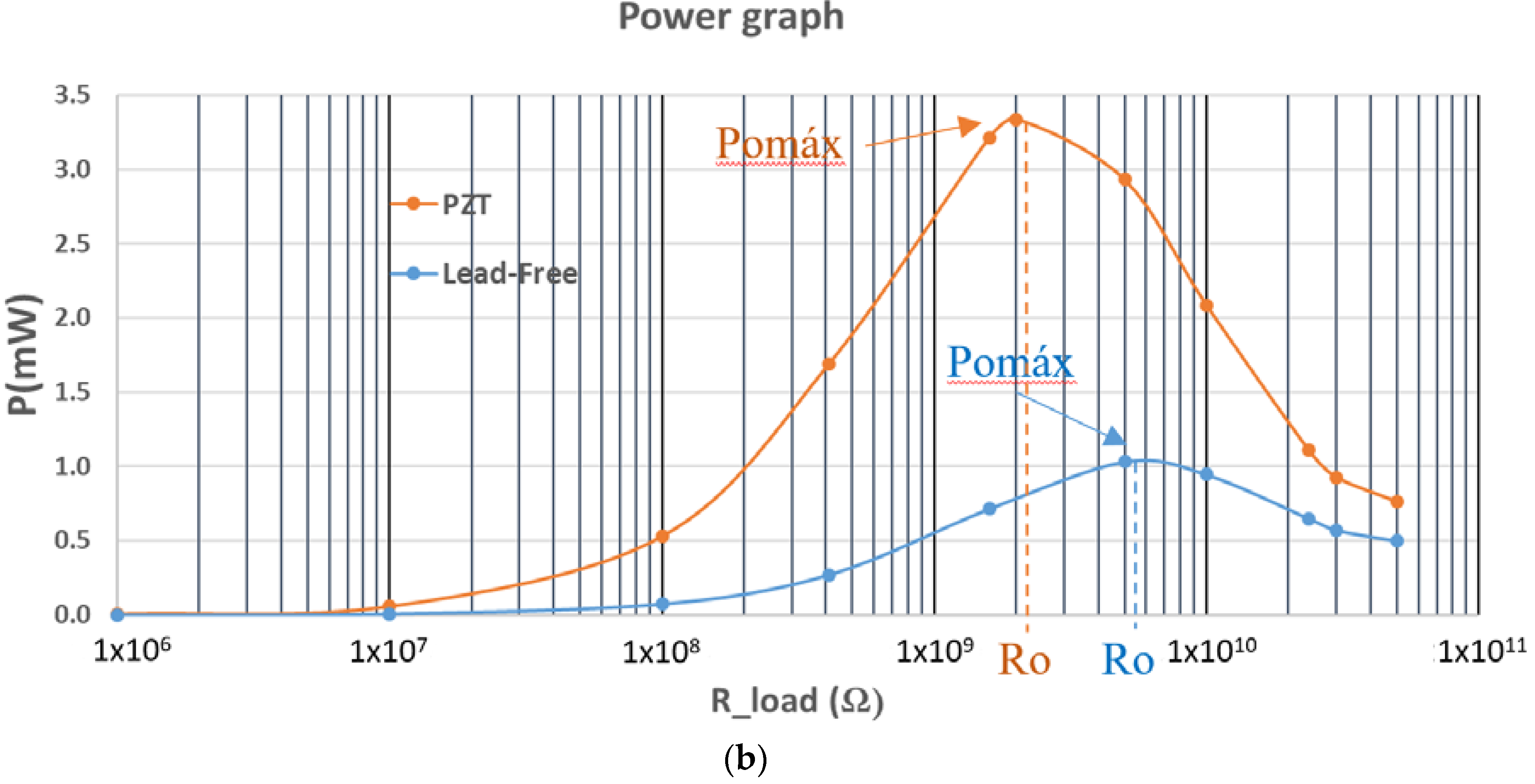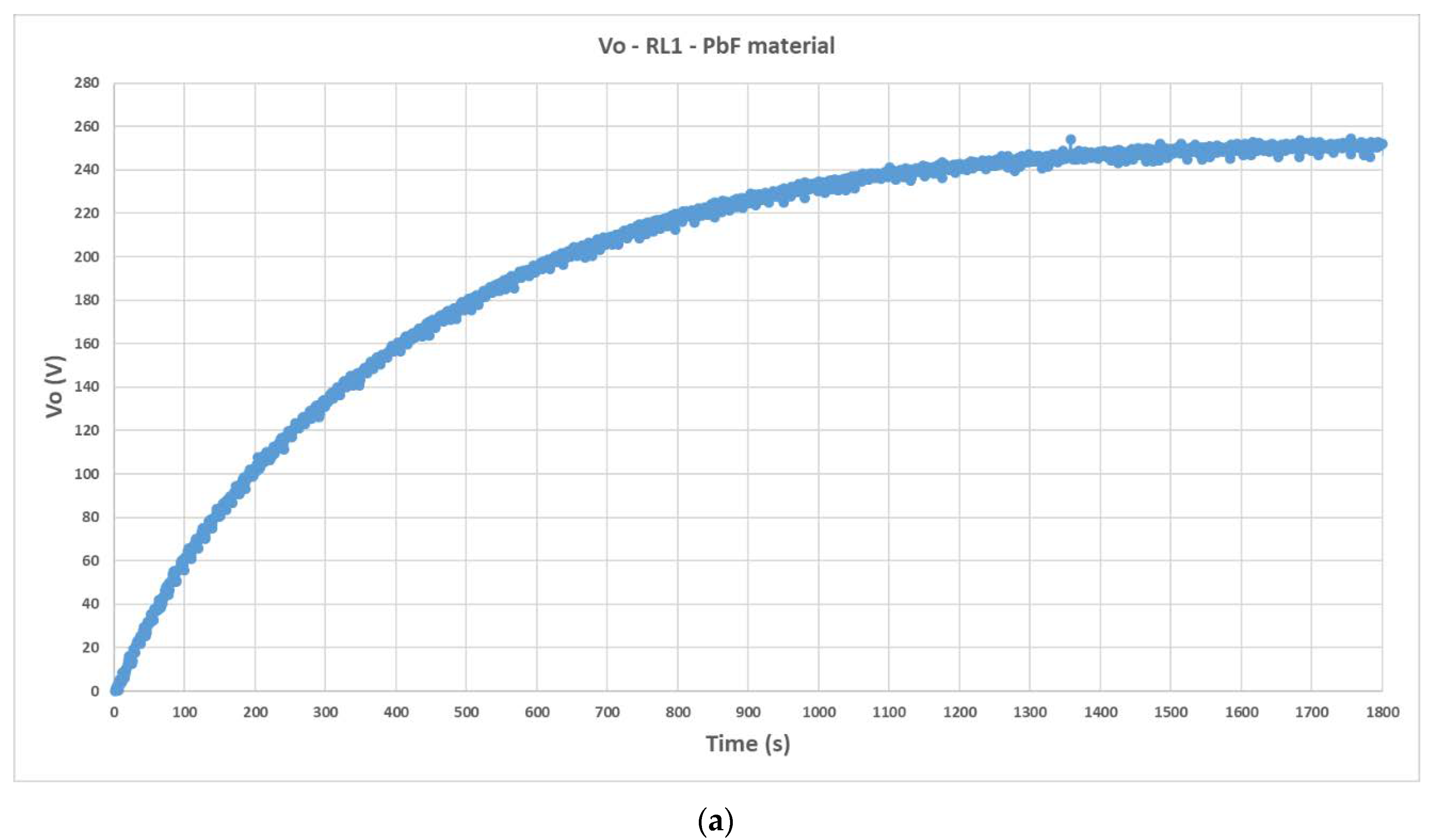A New Prospect in Road Traffic Energy Harvesting Using Lead-Free Piezoceramics
Abstract
:1. Introduction
2. The New Piezoelectric Characterization System
- (1)
- The PDUTs are electrically characterized. Their impedance is measured with an impedance meter. The piezoelectric elements are placed in the test bench.
- (2)
- The test bench is set in action. The piezoelectric voltage is acquired and its active Fourier model is calculated. The active Fourier model is obtained by calculating each Fourier component of the inner piezoelectric generators, taking into account the input impedance of the measurement equipment and the impedance of the PDUTs.
- (3)
- The active Fourier model is sent to the LabVIEW® PSpice-based software module. An iterative process is started. The harvesting circuit formed by a capacitor-filtered rectifier stage is simulated for n different load resistance values. The high accuracy of the active Fourier models achieves a low simulation error.
- (4)
- The VI computes the voltage–current and power graphs. A first estimation of the open circuit voltage (Voc) and the equivalent output resistance (Ro) of the harvester in the maximum power zone is obtained.
- (5)
- The next step is to verify the accuracy of the first estimation obtained for the key parameters Voc and Ro. Analyzing the simulation results, a pair of appropriate values for the load resistance (Rload1 and Rload2) are chosen. These resistor values are connected in the HEH module.
- (6)
- The test bench is set in action. The voltage, current, and power are registered for both load resistance values.
- (7)
- The practical values of output resistance (Ro), open circuit voltage (Voc), and maximum power point (Pomax) are obtained and empirically verified.
2.1. Piezoelectric Ceramic Material Characterization under Harvesting Conditions
2.1.1. Impedance of the PDUTs
2.1.2. Piezoelectrically Active Electrical Model
3. Energy Harvesting Results
4. Conclusions
Author Contributions
Funding
Acknowledgments
Conflicts of Interest
References
- Red Eléctrica de España. Available online: https://www.ree.es/sites/default/files/11_PUBLICACIONES/Documentos/InformesSistemaElectrico/2018/inf_sis_elec_ree_2018.pdf (accessed on 29 September 2019).
- Villafuerte-Castrejón, M.E.; Morán, E.; Reyes-Montero, A.; Vivar-Ocampo, R.; Peña-Jiménez, J.-A.; Rea-López, S.-O.; Pardo, L. Towards Lead-Free Piezoceramics: Facing a Synthesis Challenge. Materials 2016, 9, 21. [Google Scholar] [CrossRef] [PubMed]
- Calio, R.; Rongala, U.B.; Camboni, D.; Milazzo, M.; Stefanini, C.; de Petris, G.; Oddo, C.M. Piezoelectric Energy Harvesting Solutions. Sensors 2014, 14, 4755–4790. [Google Scholar] [CrossRef] [PubMed]
- Abramovich, H.; Har-nes, I. Analysis and Experimental Validation of a Piezoelectric Harvester with Enhanced Frequency Bandwidth. Materials 2018, 11, 1243. [Google Scholar] [CrossRef] [PubMed]
- Zhao, H.; Yu, J.; Ling, J. Finite element analysis of Cymbal piezoelectric transducers for harvesting energy from asphalt. J. Ceram. Soc. Jpn. 2010, 118, 909–915. [Google Scholar] [CrossRef]
- Zhao, H.; Ling, J.; Yu, J. A comparative analysis of piezoelectric transducers for harvesting energy from asphalt pavement. J. Ceram. Soc. Jpn. 2012, 120, 317–323. [Google Scholar] [CrossRef]
- Zhao, H.; Qin, L.; Ling, J. Test and Analysis of Bridge Transducers for Harvesting Energy from Asphalt Pavement. Int. J. Transp. Sci. Technol. 2015, 4, 17–28. [Google Scholar] [CrossRef]
- Roshani, H.; Dessouky, S.; Montoya, A.; Papagiannakis, A.T. Energy harvesting from asphalt pavement roadways vehicle-induced stresses: A feasibility study. Appl. Energy 2016, 30, 210–218. [Google Scholar] [CrossRef]
- Xiong, H.; Wang, L. Piezoelectric energy harvester for public roadway: On-site installation and evaluation. Appl. Energy 2016, 174, 101–107. [Google Scholar] [CrossRef]
- Papagiannakis, A.G.; Dessouky, S.; Montoya, A.; Roshani, H. Energy Harvesting from Roadways. Procedia Comput. Sci. 2016, 83, 758–765. [Google Scholar] [CrossRef]
- Yesner, G.; Kuciej, M.; Safari, A.; Jasim, A.; Wang, H.; Maher, A. Piezoelectric Energy Harvesting Using a Novel Cymbal Transducer Design. In Proceedings of the 2016 Joint IEEE International Symposium on the Applications of Ferroelectrics, European Conference on Application of Polar Dielectrics, and Piezoelectric Force Microscopy Workshop (ISAF/ECAPD/PFM), Darmstadt, Germany, 21–25 August 2016. [Google Scholar]
- Song, Y.; Yang, C.H.; Hong, S.K.; Hwang, S.J.; Kim, J.H.; Choi, J.Y.; Ryu, S.K.; Sung, T.H. Road energy harvester designed as a macro-power source using the piezoelectric effect. Int. J. Hydrogen Energy 2016, 41, 12563–12568. [Google Scholar] [CrossRef]
- Chen, Y.; Zhang, Y.; Li, C.; Yang, Q.; Zheng, H.; Lü, C. Mechanical Energy Harvesting from Road Pavements Under Vehicular Load Using Embedded Piezoelectric Elements. J. Appl. Mech. 2016, 83, 081001. [Google Scholar] [CrossRef]
- Jung, I.; Shin, Y.-H.; Kim, S.; Choi, J.; Kang, C.-Y. Flexible piezoelectric polymer-based energy harvesting system for roadway applications. Appl. Energy 2017, 197, 222–229. [Google Scholar] [CrossRef]
- Guo, L.; Lu, Q. Modeling a new energy harvesting pavement system with experimental verification. Appl. Energy 2017, 208, 1071–1082. [Google Scholar] [CrossRef]
- Yang, H.; Wang, L.; Zhou, B.; Wei, Y.; Zhao, Q. A preliminary study on the highway piezoelectric power supply system. Int. J. Pavement Res. Technol. 2018, 11, 168–175. [Google Scholar] [CrossRef]
- Roshani, H.; Jagtap, P.; Dessouky, S.; Montoya, A.; Papagiannakis, A.T. Theoretical and Experimental Evaluation of Two Roadway Piezoelectric-Based Energy Harvesting Prototypes. J. Mater. Civ. Eng. 2018, 30, 04017264. [Google Scholar] [CrossRef]
- DNV KEMA Energy & Sustainability. Final Project Report: Assesment of Piezoelectric Materials for Roadway Energy Harvesting: Cost of Energy and Demonstration Roadmap; California Energy Commission: Sacramento, CA, USA, 2014. [Google Scholar]
- Vázquez Rodríguez, M. Contribución al Estudio de la Generación de Energía Eléctrica a Partir de Materiales Piezoeléctricos. Ph.D. Thesis, Universidad Politécnica de Madrid, Madrid, Spain, 2019. [Google Scholar] [CrossRef]
- Vázquez-Rodríguez, M.; Jiménez, F.J.; de Frutos, J.; Alonso, D. Piezoelectric energy harvesting computer controlled test bench. Rev. Sci. Instrum. 2016, 87, 095004. [Google Scholar] [CrossRef]
- Vázquez-Rodríguez, M.; Jiménez, F.J.; de Frutos, J. Virtual instrument to obtain electrical models of piezoelectric elements used in energy harvesting. Adv. Appl. Ceram. 2018, 117, 201–211. [Google Scholar] [CrossRef]



















| Published [Reference] | Contribution |
|---|---|
| 2010 [5] | Finite elements theoretical and simulation study of the application of cymbal-type housing for piezoelectric materials. 1.2 mW generated at 20 Hz |
| 2012 [6] | Several piezoelectric packages are studied using the finite elements technique for asphalt inlay highlighting cymbal and bridge for its efficiency in energy conversion |
| 2015 [7] | Three encapsulation options for bridge-type housing are studied to minimize the fracture of the piezoelectric material by fatigue. It is concluded that the arch bridge is optimal for burying on asphalt. An applied pressure of 0.7 MPa generated 286 V |
| 2016 [8] | A prototype consisting of 4, 8, or 16 piezoelectric disks sandwiched between two copper plates was assembled in-between asphalt mixtures. A uniaxial compression test was performed to measure the output power directly on a resistor |
| 2016 [9] | Based on the Ph. D. thesis of the first author, piezoelectric degradation measurements in an USA real road installation are presented. Over 14% of the asphalt stress produced by the vehicles is transmitted to the road-embedded prototypes producing 3.106 mW of harvested power |
| 2016 [10] | Two prototypes formed by stacked prismatic or cylindrical piezoelectric elements are tested in the laboratory. Assuming daily moderately busy USA Interstate highway traffic of 30,000 vehicles/day, the first prototype will produce 9.66 Wh per year and the second one 240.95 Wh |
| 2016 [11] | A cymbal structure is modified in seven piezoelectric parallelized sections. In a laboratory test over a 400 kΩ resistor, 2.1 mW of power is produced |
| 2016 [12] | An association of piezoelectric cantilevers produces 184 µW over an empirically optimized resistor of 70 kΩ. A Universal Test Machine (UTM) performs the laboratory tests |
| 2016 [13] | Wheel tracking tests are performed assuming a continuous rate of traffic. Several recommendations are obtained to adjust the geometry and composition of the piezoelectric material in order to maximize the extracted power in response to variable speed and distance between vehicles |
| 2017 [14] | Up to 60 PVDF layers are associated in parallel to generate 200 mW of peak power. Viability of using flexible material is shown |
| 2017 [15] | A new structure formed by a layer of piezoelectric material embedded between two layers of conductive asphalt generates 1.2 mW in UTM tests |
| 2018 [16] | A stacked array type of piezoelectric energy harvester is field-tested, generating a voltage between 250 and 400 V when a test vehicle is passes. The obtained piezoelectric energy lights LED signs |
| 2018 [17] | A new prototype of 11 stacked piezoelectric elements is presented and compared to the prototype results presented in [8]. The energy output estimated per prototypes I and II was 360 and 171 Wh annually |
| Material | g33 (10−3 Vm/N) | d33 (10−12 C/N) | s33D (10−12 m2/N) | K33T | tan δ (%) | k33 |
|---|---|---|---|---|---|---|
| PZT | 26 | >260 | 12.5 | 1280 | 0.6 | >0.68 |
| BNBT | 16 | 98 | 7.5 | 710 | 0.4 | 0.40 |
| Parameter | PZT | PIC700 |
|---|---|---|
| Ro (GΩ) | 2.36 | 5.57 |
| V*oc (V) | 5640 | 4800 |
| Pomax (mW) | 3.4 | 1.03 |
| Measurements | Simulations | Er % |
|---|---|---|
| 2.36 GΩ | −2.54 |
| Measurements | Simulations | Er % |
|---|---|---|
| 5.57 GΩ | −2.15 |
© 2019 by the authors. Licensee MDPI, Basel, Switzerland. This article is an open access article distributed under the terms and conditions of the Creative Commons Attribution (CC BY) license (http://creativecommons.org/licenses/by/4.0/).
Share and Cite
Vázquez-Rodríguez, M.; Jiménez, F.J.; Pardo, L.; Ochoa, P.; González, A.M.; de Frutos, J. A New Prospect in Road Traffic Energy Harvesting Using Lead-Free Piezoceramics. Materials 2019, 12, 3725. https://doi.org/10.3390/ma12223725
Vázquez-Rodríguez M, Jiménez FJ, Pardo L, Ochoa P, González AM, de Frutos J. A New Prospect in Road Traffic Energy Harvesting Using Lead-Free Piezoceramics. Materials. 2019; 12(22):3725. https://doi.org/10.3390/ma12223725
Chicago/Turabian StyleVázquez-Rodríguez, Manuel, Francisco J. Jiménez, Lorena Pardo, Pilar Ochoa, Amador M. González, and José de Frutos. 2019. "A New Prospect in Road Traffic Energy Harvesting Using Lead-Free Piezoceramics" Materials 12, no. 22: 3725. https://doi.org/10.3390/ma12223725





